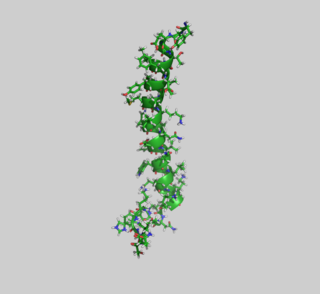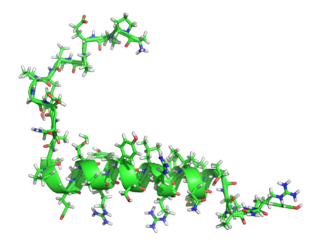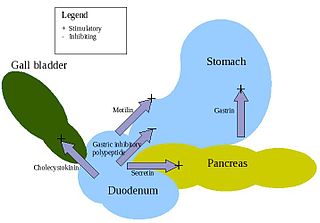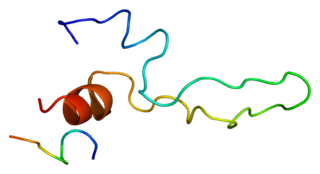Related Research Articles

Secretin is a hormone that regulates water homeostasis throughout the body and influences the environment of the duodenum by regulating secretions in the stomach, pancreas, and liver. It is a peptide hormone produced in the S cells of the duodenum, which are located in the intestinal glands. In humans, the secretin peptide is encoded by the SCT gene.

Cholecystokinin is a peptide hormone of the gastrointestinal system responsible for stimulating the digestion of fat and protein. Cholecystokinin, officially called pancreozymin, is synthesized and secreted by enteroendocrine cells in the duodenum, the first segment of the small intestine. Its presence causes the release of digestive enzymes and bile from the pancreas and gallbladder, respectively, and also acts as a hunger suppressant.

Gastrin is a peptide hormone that stimulates secretion of gastric acid (HCl) by the parietal cells of the stomach and aids in gastric motility. It is released by G cells in the pyloric antrum of the stomach, duodenum, and the pancreas.
Gastric acid, gastric juice, or stomach acid, is a digestive fluid formed within the stomach lining. Composed of hydrochloric acid, potassium chloride, and sodium chloride, gastric acid plays a key role in digestion of proteins by activating digestive enzymes, which together break down the long chains of amino acids of proteins. Gastric acid is regulated in feedback systems to increase production when needed, such as after a meal. Other cells in the stomach produce bicarbonate, a base, to buffer the fluid, ensuring a regulated pH. These cells also produce mucus – a viscous barrier to prevent gastric acid from damaging the stomach. The pancreas further produces large amounts of bicarbonate and secretes bicarbonate through the pancreatic duct to the duodenum to neutralize gastric acid passing into the digestive tract.
Digestive enzymes are a group of enzymes that break down polymeric macromolecules into their smaller building blocks, in order to facilitate their absorption by the body. Digestive enzymes are found in the digestive tracts of animals and in the tracts of carnivorous plants, where they aid in the digestion of food, as well as inside cells, especially in their lysosomes, where they function to maintain cellular survival. Digestive enzymes of diverse specificities are found in the saliva secreted by the salivary glands, in the secretions of cells lining the stomach, in the pancreatic juice secreted by pancreatic exocrine cells, and in the secretions of cells lining the small and large intestines.

Incretins are a group of metabolic hormones that stimulate a decrease in blood glucose levels. Incretins are released after eating and augment the secretion of insulin released from pancreatic beta cells of the islets of Langerhans by a blood glucose-dependent mechanism.

Gastric inhibitory polypeptide (GIP), or gastric inhibitory peptide, also known as glucose-dependent insulinotropic polypeptide, is an inhibiting hormone of the secretin family of hormones. While it is weak inhibitor of gastric acid secretion, its main role is to stimulate insulin secretion.

Pancreatic polypeptide (PP) is a polypeptide secreted by PP cells in the endocrine pancreas predominantly in the head of the pancreas. It consists of 36 amino acids and has molecular weight about 4200 Da. The function of PP is to self-regulate pancreatic secretion activities. It also has effects on hepatic glycogen levels and gastrointestinal secretions.
Somatostatinomas are a tumor of the delta cells of the endocrine pancreas that produces somatostatin. Increased levels of somatostatin inhibit pancreatic hormones and gastrointestinal hormones. Thus somatostatinomas are associated with mild diabetes mellitus, steatorrhoea and gallstones, and achlorhydria. Somatostatinomas are commonly found in head of pancreas. Only ten percent of somatostatinomas are functional tumours [9], and 60-70% of tumours are malignant. Nearly two thirds of patients with malignant somatostatinomas will present with metastatic disease.
The gastrointestinal hormones constitute a group of hormones secreted by enteroendocrine cells in the stomach, pancreas, and small intestine that control various functions of the digestive organs. Later studies showed that most of the gut peptides, such as secretin, cholecystokinin or substance P, were found to play a role of neurotransmitters and neuromodulators in the central and peripheral nervous systems.

Enteroendocrine cells are specialized cells of the gastrointestinal tract and pancreas with endocrine function. They produce gastrointestinal hormones or peptides in response to various stimuli and release them into the bloodstream for systemic effect, diffuse them as local messengers, or transmit them to the enteric nervous system to activate nervous responses. Enteroendocrine cells of the intestine are the most numerous endocrine cells of the body. They constitute an enteric endocrine system as a subset of the endocrine system just as the enteric nervous system is a subset of the nervous system. In a sense they are known to act as chemoreceptors, initiating digestive actions and detecting harmful substances and initiating protective responses. Enteroendocrine cells are located in the stomach, in the intestine and in the pancreas.

The gastric inhibitory polypeptide receptor (GIP-R), also known as the glucose-dependent insulinotropic polypeptide receptor, is a protein that in humans is encoded by the GIPR gene. GIP-R is a member of the 7-transmembrane protein family, a class of G protein

The cholecystokinin B receptor also known as CCKBR or CCK2 is a protein that in humans is encoded by the CCKBR gene.

The Cholecystokinin A receptor is a human protein, also known as CCKAR or CCK1, with CCK1 now being the IUPHAR-recommended name.
Secretin family receptor proteins, also known as Family B or family 2 of G-protein coupled receptors are regulated by peptide hormones from the glucagon hormone family. The family is different from adhesion G protein-coupled receptors.

Glucagon/GIP/secretin/VIP hormones are a family of evolutionarily related peptide hormones that regulate activity of G-protein coupled receptors from secretin receptor family.
A cholecystokinin antagonist is a specific type of receptor antagonist which blocks the receptor sites for the peptide hormone cholecystokinin (CCK).

Devazepide is benzodiazepine drug, but with quite different actions from most benzodiazepines, lacking affinity for GABAA receptors and instead acting as an CCKA receptor antagonist. It increases appetite and accelerates gastric emptying, and has been suggested as a potential treatment for a variety of gastrointestinal problems including dyspepsia, gastroparesis and gastric reflux. It is also widely used in scientific research into the CCKA receptor.
The nervous system, and endocrine system collaborate in the digestive system to control gastric secretions, and motility associated with the movement of food throughout the gastrointestinal tract, including peristalsis, and segmentation contractions.
Local hormones are a large group of signaling molecules that do not circulate within the blood. Local hormones are produced by nerve and gland cells and bind to either neighboring cells or the same type of cell that produced them. Local hormones are activated and inactivated quickly. They are released during physical work and exercise. They mainly control smooth and vascular muscle dilation. Strength of response is dependent upon the concentration of receptors of target cell and the amount of ligand.
References
- ↑ You C, Chey W (1987). "Secretin is an enterogastrone in humans". Dig Dis Sci. 32 (5): 466–71. doi:10.1007/BF01296028. PMID 2952476.
- ↑ Lloyd K, Maxwell V, Chuang C, Wong H, Soll A, Walsh J (1994). "Somatostatin is released in response to cholecystokinin by activation of type A CCK receptors". Peptides. 15 (2): 223–7. doi:10.1016/0196-9781(94)90006-X. PMID 7911992.